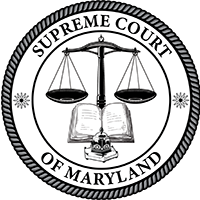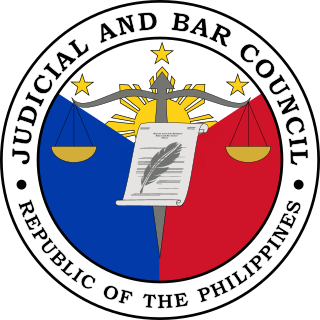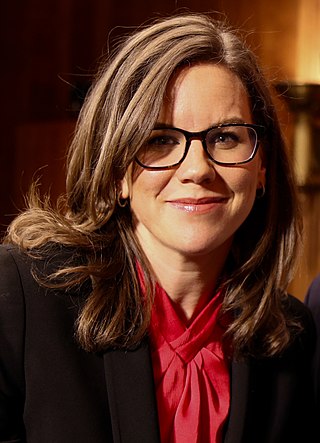
The Supreme Court of Maryland is the highest court of the U.S. state of Maryland. The court, which is composed of one chief justice and six associate justices, meets in the Robert C. Murphy Courts of Appeal Building in the state capital, Annapolis. The term of the Court begins the second Monday of September. The Court is unique among American courts in that the justices wear red robes.

Speculation abounded over potential nominations to the Supreme Court of the United States by President George W. Bush since before his presidency.

The Supreme Court of Oklahoma is a court of appeal for non-criminal cases, one of the two highest judicial bodies in the U.S. state of Oklahoma, and leads the judiciary of Oklahoma, the judicial branch of the government of Oklahoma.
The Tennessee Plan is a system used to appoint and elect appellate court judges in Tennessee. It is largely patterned after the Missouri Plan, and an earlier version in Tennessee was called the Modified Missouri Plan. At the end of every judge's eight-year term following a judicial appointment to the highest courts, retention elections are held, which have the option of whether each judge shall be retained through a yes-no option. This system applies to the Tennessee Supreme Court, the Tennessee Court of Appeals, and the Tennessee Court of Criminal Appeals.

The Vermont Senate is the upper house of the Vermont General Assembly, the state legislature of the U.S. state of Vermont. The senate consists of 30 members elected from multi-member districts. Each senator represents at least 20,300 citizens. Senators are elected to two-year terms and there is no limit to the number of terms that a senator may serve.

The Judicial and Bar Council of the Philippines is a constitutionally-created body that recommends appointees for vacancies that may arise in the composition of the Supreme Court, other lower courts, and the Legal Education Board, and in the offices of the Ombudsman, Deputy Ombudsman and the Special Prosecutor.

The New Mexico Supreme Court is the highest court in the U.S. state of New Mexico. It is established and its powers defined by Article VI of the New Mexico Constitution. It is primarily an appellate court which reviews civil and criminal decisions of New Mexico's trial courts of general jurisdiction and certain specialized legislative courts, only having original jurisdiction in a limited number of actions. It currently resides in the New Mexico Supreme Court Building in Santa Fe.
The Government of Guam (GovGuam) is a presidential representative democratic system, whereby the president is the head of state and the governor is head of government, and of a multi-party system. Guam is an organized, unincorporated territory of the United States with policy relations between Guam and the US under the jurisdiction of the Office of Insular Affairs.

The Government of Tennessee is organized under the provisions of the 1870 Constitution of Tennessee, first adopted in 1796. As set forth by the state constitution, administrative influence in Tennessee is divided among three branches of government: executive, legislative, and judicial.
The Judiciary of Vermont is the state court system of Vermont, charged with Vermont law.

Beth Robinson is an American lawyer and judge from Vermont. She is a United States circuit judge of the United States Court of Appeals for the Second Circuit and is the first openly lesbian judge to serve on any federal court of appeals. Robinson served as an associate justice of the Vermont Supreme Court from 2011 to 2021.
The Judiciary of Virginia is defined under the Constitution and law of Virginia and is composed of the Supreme Court of Virginia and subordinate courts, including the Court of Appeals, the Circuit Courts, and the General District Courts. Its administration is headed by the Chief Justice of the Supreme Court, the Judicial Council, the Committee on District Courts, the Judicial Conferences, the Judicial Inquiry and Review Commission, and various other offices and officers.
Charles Jones Bethel is an associate justice of the Supreme Court of Georgia. He is a former Judge of the Georgia Court of Appeals. Before his judicial tenure, he served as Senator in the Georgia General Assembly from Dalton, Georgia. Bethel was first elected Senator in the 2010 general election and served Georgia's 54th district—a constituency which includes Murray and Whitfield counties, and portions of Gordon and Pickens counties as well.

Michael P. Boggs is the chief justice of the Supreme Court of Georgia, a former judge of the Georgia Court of Appeals and a former nominee to be a United States district judge of the United States District Court for the Northern District of Georgia. He was appointed to the state Supreme Court by Georgia Governor Nathan Deal.

Geoffrey William Crawford is the chief United States district judge of the United States District Court for the District of Vermont and former associate justice of the Vermont Supreme Court.

Joan Louise Larsen is an American attorney serving as a United States circuit judge of the United States Court of Appeals for the Sixth Circuit. She previously was an associate justice of the Michigan Supreme Court from 2015 to 2017.

Britt Cagle Grant is an American attorney and judge who is a United States circuit judge of the United States Court of Appeals for the Eleventh Circuit. She is a former Justice of the Supreme Court of Georgia.

Robert Joshua Luck is an American lawyer and jurist who serves as a United States circuit judge of the United States Court of Appeals for the Eleventh Circuit and was formerly a justice of the Florida Supreme Court. A Miami native, he has previously served as an Assistant United States Attorney and as a judge on the Eleventh Judicial Circuit Court of Florida and then the Florida Third District Court of Appeal.

Holly Aiyisha Thomas is an American attorney serving as a United States circuit judge of the United States Court of Appeals for the Ninth Circuit. She previously served as a judge of the Los Angeles County Superior Court from 2018 to 2022.


















